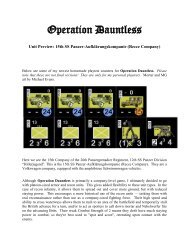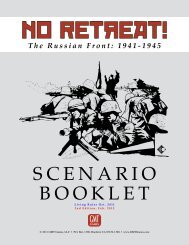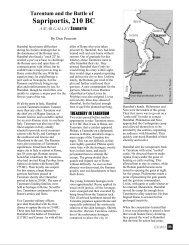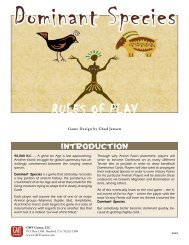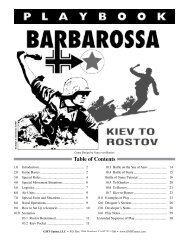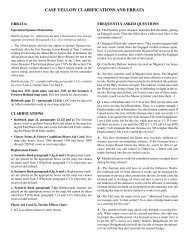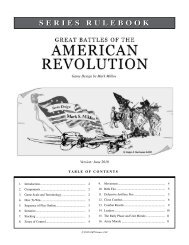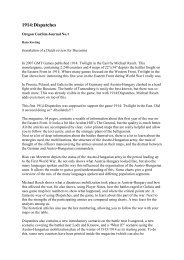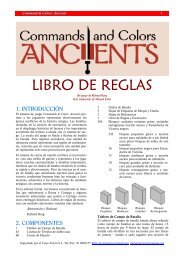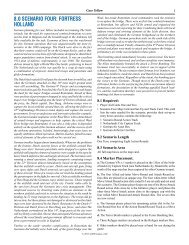Create successful ePaper yourself
Turn your PDF publications into a flip-book with our unique Google optimized e-Paper software.
6<br />
Newtown <strong>Exclusive</strong> <strong>Rules</strong><br />
V. Indian <strong>Rules</strong><br />
5.1 Indian Honor<br />
At the start of the game the Indian player rolls on the<br />
Indian Honor Table to determine which tribe/clan begins<br />
the game “with Honor”.<br />
5.1.1 Assignment of Honor<br />
One combat unit in the designated tribe/clan<br />
(Indian player’s choice) is assigned the Honor<br />
marker, which is placed under the selected<br />
unit.<br />
5.1.2 Effects of Honor<br />
• The unit “with Honor” receives +1 to its Unit Morale<br />
for all purposes.<br />
• The unit with Honor must be the Lead Unit if involved<br />
in Close Combat, or Honor is lost and the marker is<br />
immediately removed and set aside for reassignment<br />
in the End Phase (see 5.1.4).<br />
5.1.3 Loss of Honor<br />
• The Honor marker is removed as in rule 5.1.2 above.<br />
• The Honor marker is removed if the owning unit fails<br />
an Indian Resolve Morale Check (see 5.4.2).<br />
• The Honor marker is removed if the owning unit is the<br />
Lead Unit in a Close Combat that produces any adverse<br />
results impacting that Lead Unit: NC, R, D, PIN, R/R,<br />
1, 2, C.<br />
Design Note: Although “NC” is not specifically an adverse<br />
result, if an Indian unit with Honor entered combat and<br />
was not able to bring the enemy to bear and produce a<br />
victorious result, the detrimental effects to that unit’s Honor<br />
among the tribes would be much the same.<br />
Clarification: Honor is not lost by choosing Indian<br />
Withdrawal, which is not a combat result.<br />
5.1.4 Honor Reassignment<br />
• During the End Phase of the current Indian Player Turn,<br />
roll on the Indian Honor Table to determine the next<br />
tribe/clan from which the Indian player will choose the<br />
combat unit that will receive the Honor marker.<br />
• If Honor was not lost during the current Game Turn,<br />
no roll is made.<br />
• To receive Honor a unit must be in Parade Order. In<br />
addition, Honor cannot be assigned to a unit marked<br />
with Failed Resolve, nor to the unit that just lost the<br />
Honor marker in the current Player Turn.<br />
• If the die roll does not result in an eligible combat unit<br />
for Honor marker placement, then Honor is not assigned<br />
and the marker should be placed on the next turn of the<br />
© 2013 <strong>GMT</strong> <strong>Games</strong>, LLC<br />
Game Turn Track. Honor will then be rolled for again<br />
during the next Indian player End Phase.<br />
• The Tuscarora, Seven Nations (optional) and Onondaga<br />
(possible pre-game enhancement result) units can never<br />
own the Honor marker.<br />
5.2 Indian Player Movement Phases<br />
The Indian Player Turn has three distinct Movement<br />
Phases (see the Sequence of Play).<br />
5.2.1 Standard Movement Phase<br />
The Indian player may move his non-Indian combat units:<br />
British Regulars, Butler’s Rangers, and the Mohawk Valley<br />
Militia.<br />
5.2.2 Activation Movement Phase<br />
Design Note: Newtown introduces a chit-pull mechanic<br />
that controls the movement of Indian combat units (only)<br />
in the Indian player Movement Phase.<br />
• The Indian player draws Activation markers one at a<br />
time from the container and moves only those units<br />
corresponding to the Activation marker drawn.<br />
Note: The Mohawk Valley Militia can<br />
move in the Standard Movement Phase<br />
or in the Activation Movement Phase<br />
with the Mohawk tribe when their marker<br />
is drawn (not both).<br />
Note: The counter mix includes two activation<br />
markers for the Mohawk and<br />
Mohawk Valley Militia. Both markers go<br />
in the cup, but only the first marker drawn<br />
is used—the second is ignored.<br />
Design Note: This mechanic demonstrates these units’<br />
mobility in a tempered fashion by increasing the chance<br />
of their markers being drawn, rather than allowing them<br />
to move twice outright.<br />
Note: The Seneca tribe consists<br />
of the Wolf Clan and the Turtle<br />
Clan. The counter mix includes<br />
two Seneca Activation Markers;<br />
one each showing a wolf’s paw print and a turtle.<br />
Likewise, each Seneca combat unit and leader features<br />
one or the other of these totems. Only those units in<br />
the Clan corresponding to the totem on the Activation<br />
marker drawn (wolf or turtle) can move when its<br />
Activation marker is drawn.




